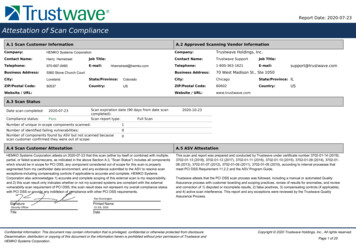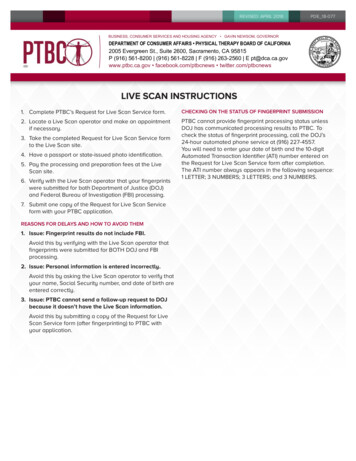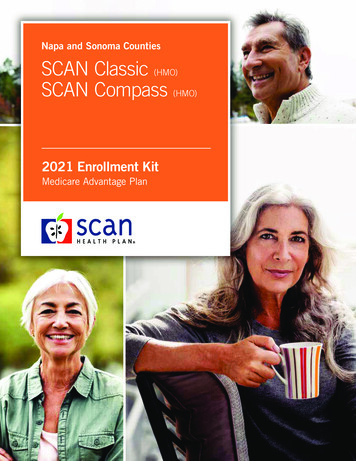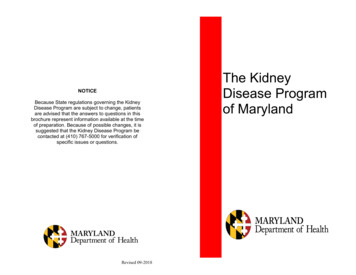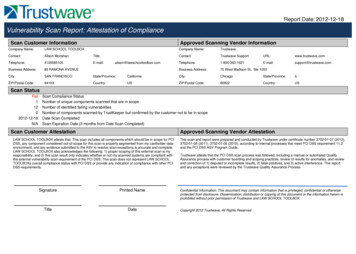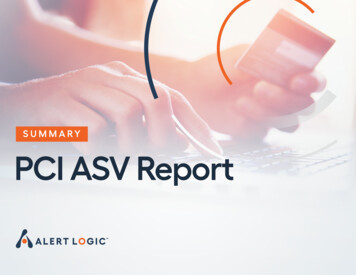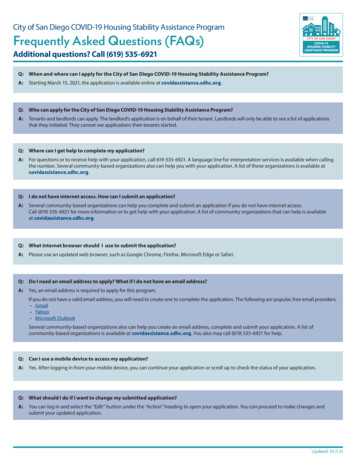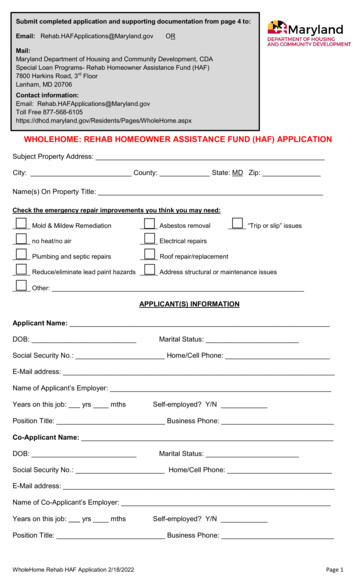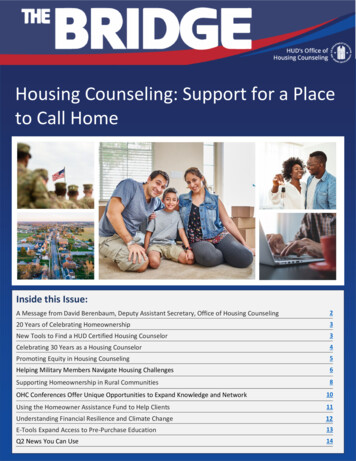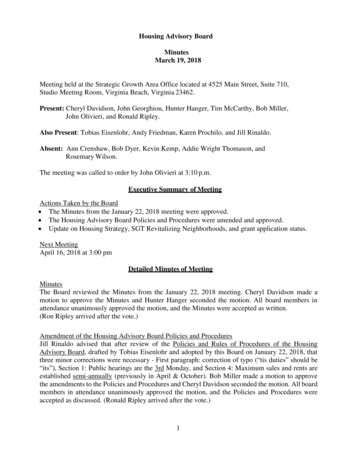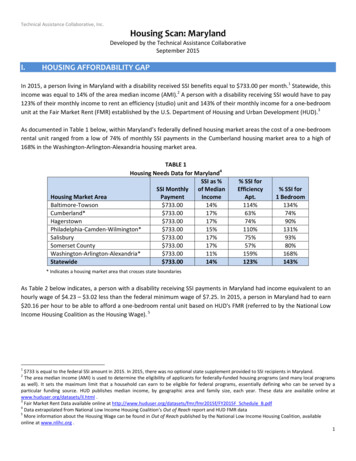
Transcription
Technical Assistance Collaborative, Inc.Housing Scan: MarylandDeveloped by the Technical Assistance CollaborativeSeptember 2015I.HOUSING AFFORDABILITY GAPIn 2015, a person living in Maryland with a disability received SSI benefits equal to 733.00 per month.1 Statewide, thisincome was equal to 14% of the area median income (AMI).2 A person with a disability receiving SSI would have to pay123% of their monthly income to rent an efficiency (studio) unit and 143% of their monthly income for a one‐bedroomunit at the Fair Market Rent (FMR) established by the U.S. Department of Housing and Urban Development (HUD).3As documented in Table 1 below, within Maryland’s federally defined housing market areas the cost of a one‐bedroomrental unit ranged from a low of 74% of monthly SSI payments in the Cumberland housing market area to a high of168% in the Washington‐Arlington‐Alexandria housing market area.TABLE 1Housing Needs Data for Maryland4SSI as %SSI Monthly of MedianHousing Market AreaPaymentIncomeBaltimore‐Towson 733.0014%Cumberland* 733.0017%Hagerstown 733.0017%Philadelphia‐Camden‐Wilmington* 733.0015%Salisbury 733.0017%Somerset County 733.0017%Washington‐Arlington‐Alexandria* 733.0011%Statewide 733.0014%% SSI forEfficiencyApt.114%63%74%110%75%57%159%123%% SSI for1 Bedroom134%74%90%131%93%80%168%143%* Indicates a housing market area that crosses state boundariesAs Table 2 below indicates, a person with a disability receiving SSI payments in Maryland had income equivalent to anhourly wage of 4.23 – 3.02 less than the federal minimum wage of 7.25. In 2015, a person in Maryland had to earn 20.16 per hour to be able to afford a one‐bedroom rental unit based on HUD's FMR (referred to by the National LowIncome Housing Coalition as the Housing Wage). 51 733 is equal to the federal SSI amount in 2015. In 2015, there was no optional state supplement provided to SSI recipients in Maryland.The area median income (AMI) is used to determine the eligibility of applicants for federally‐funded housing programs (and many local programsas well). It sets the maximum limit that a household can earn to be eligible for federal programs, essentially defining who can be served by aparticular funding source. HUD publishes median income, by geographic area and family size, each year. These data are available online atwww.huduser.org/datasets/il.html .3Fair Market Rent Data available online at 5F Schedule B.pdf4Data extrapolated from National Low Income Housing Coalition’s Out of Reach report and HUD FMR data5More information about the Housing Wage can be found in Out of Reach published by the National Low Income Housing Coalition, availableonline at www.nlihc.org .12
Technical Assistance Collaborative, Inc.TABLE 22015 SSI Payments as an Hourly Wage – MarylandNLIHC Housing WageHousing Market AreaSSI As Hourly Wage for 1 bedroom FMRBaltimore‐Towson 4.23 18.94Cumberland* 4.23 10.42Hagerstown 4.23 12.73Philadelphia‐Camden‐Wilmington* 4.23 18.44Salisbury 4.23 13.10Somerset County 4.23 11.33Washington‐Arlington‐Alexandria* 4.23 23.65Non‐Metropolitan Area 4.23 15.19Statewide 4.23 20.16* Indicates a housing market area that crosses state boundariesII.HOUSING RESOURCESA. U.S. Department of Housing and Urban Development (HUD)HUD provides a variety of resources to states, local governments, and non‐profit housing agencies to provide access toor to develop affordable housing. This housing scan describes some of those resources of most value to expandinghousing options for people with disabilities and elders transitioning from nursing homes and other health careinstitutions into the community including: Housing Choice Vouchers (HCV), including special purpose vouchersFederal Public Housing UnitsHome Investments Partnership ProgramHousing Opportunities for Persons with AIDS (HOPWA)Section 811 Supportive Housing for Persons with Disabilities ProgramSection 202 Supportive Housing for the Elderly ProgramContinuum of Care Homeless Programs1. Resources Administered by Public Housing Agencies (PHAs)PHAs are public agencies overseen by a Board of Commissioners that is either elected or appointed by the city or town.PHAs were created with passage of the first Housing Act in 1937 to develop, own, and manage public housing undercontract with HUD. PHAs can administer conventional public housing units, Housing Choice vouchers, or both, as well asnumerous other affordable housing programs.a. Housing Choice Voucher ProgramThe Housing Choice Voucher program is the major federal program for assisting low‐income families, the elderly, andpeople with disabilities to obtain decent, safe, and affordable housing in the community. Vouchers are commonlyreferred to as tenant‐based rent subsidies because they are provided to eligible applicants to use in private marketrental housing of their choice that meets the HCV program requirements. The HCV household pays a portion of monthlyhousing costs that is based on the income of the household. The household’s portion is usually – but not always – equalto 30‐40% of its monthly‐adjusted income. This subsidy is based on the cost of moderately priced rental housing in thecommunity and is provided by a PHA under a contract with HUD.2
Technical Assistance Collaborative, Inc.At the present time, there are 32 PHAs in Maryland administering HCV and public housing programs. Of these, 8 PHAsadminister only an HCV program, 7 administer only a public housing program, and 17 PHAs administer both an HCV andpublic housing program. The PHAs in Maryland administer a total of 53,141 vouchers and own and operate a total of19,095 units of federally funded public housing. A list of Maryland PHAs – and the resources they control – is included inTable 3.TABLE 36PHA Contacts for MarylandPH/HCV/BothHousingChoiceVouchersPublic HousingUnitsPH075AnnapolisBoth3841,098Anne Arundel County HousingCommissionGlen BurnieBoth2,091934Baltimore City HA7BaltimoreBoth19,27511,512Baltimore County HABaltimoreHCV6,1330Calvert County HAPrince FrederickBoth33971Cambridge HACambridgePH0190Carroll County Housing &Community DevelopmentWestminsterHCV6490Cecil County HAElktonHCV6340Charles County CommissionersPort TobaccoHCV9090College Park HACollege ParkPH0108Crisfied HACrisfieldBoth23330Cumberland HACumberlandPH0425Easton HAEastonBoth13966Elkton HAElktonBoth40150Frederick HAFrederickBoth724481Frostburg HAFrostburgPH0100Glenarden HAGlenardenPH060Hagerstown HAHagerstownBoth9001,320Harford County HABel AirHCV1,2690Havre de Grace HAHavre de GracePH060PHA NameCityAllegany County HACumberlandAnnapolis HA6Data from HUD PHA Contact Information http://portal.hud.gov/hudportal/HUD?src /program offices/public indian housing/pha/contacts andHUD Housing Authority Profile database sp7This and several other PHAs are technically the “Housing Authority of ‐‐‐“. For this scan, we have placed the city/county name first in order toplace them in alphabetical order so that the reader can more easily find the data.3
Technical Assistance Collaborative, Inc.PH/HCV/BothHousingChoiceVouchersPublic HousingUnitsColumbiaBoth94450MD Department of Housing &Community DevelopmentCrownsvilleHCV2,4550Montgomery County HAKensingtonBoth7,088932Prince Georges HALargoBoth6,013377Queen Anne’s County HACentrevilleBoth13625Rockville HARockvilleBoth409341St. Mary’s County HALexington ParkBoth1,31352St. Michaels HASaint MichaelsBoth2061Washington County HAHagerstownHCV5780Westminster Housing OfficeWestminsterHCV2930Wicomico County HASalisburyBoth38327753,14119,095PHA NameCityHoward County HousingCommissionTOTALi.Special Purpose VouchersIn addition to regular Housing Choice Vouchers, there are special purpose vouchers that have been appropriated byCongress exclusively for people with disabilities. Because of various requirements imposed on these vouchers by law andby Congressional appropriations language, these vouchers are an invaluable resource for meeting the housing needs ofpeople with disabilities since they must continue to be set aside for people with disabilities even when they turnoverand are re‐issued. As documented in Table 4, of the 53,141 vouchers administered by PHAs in Maryland, 3% (1,650vouchers) are targeted exclusively to people with disabilities through the following programs: Five‐Year Mainstream Housing Opportunities for Persons with DisabilitiesFive‐Year Mainstream vouchers are set aside exclusively for people with disabilities. These vouchers are funded throughthe Section 811 tenant‐based rental assistance program (25% of the program’s appropriations have been used fortenant‐based rental assistance) and PHAs8 received five‐year annual contributions contracts. Rental Assistance for Non‐Elderly Persons with Disabilities (“NED” Vouchers)In addition to the 5‐year Mainstream vouchers, over the past decade, HUD has also awarded over 55,000 other voucherstargeted to non‐elderly people with disabilities, now referred to as NED vouchers.989Non‐profit disability organizations were also eligible to apply for Section 811‐funded Mainstream vouchers.NED vouchers include those vouchers previously known as Designated Housing vouchers, Certain Developments vouchers, Project Accessvouchers, and 1‐year Mainstream vouchers.4
Technical Assistance Collaborative, Inc. Rental Assistance for Non‐Elderly Persons with Disabilities (“NED” Category 2 Vouchers)In 2011, HUD awarded another category of vouchers targeted to non‐elderly persons with disabilities currently residingin nursing homes or other healthcare institutions who want to transition into the community. These vouchers are nowreferred to as NED Category 2 vouchers.As seen in Table 4, 11 PHAs in Maryland currently administer a total of 1,650 vouchers for people with disabilities – 240five‐year Mainstream vouchers, 1310 NED vouchers, and 100 NED Category 2 vouchers.TABLE 410PHAs in Maryland with Special Purpose VouchersPHANEDFive‐YearNEDMainstream Category 2Anne Arundel County HA01000ARC Northern Chesapeake Region0750Baltimore City175040Baltimore County HA100050Carroll County Housing & Community10000DevelopmentCharles County Commissioners10000Frederick HA5000Howard County Housing & Community25010DevelopmentMontgomery County HA660150Rockville0500St. Mary’s County HA10000TOTAL1,310240100On June 14, 2011 HUD published PIH Notice 2011‐32, a critical document for ensuring the effective utilization of all theNED vouchers described above. All PHAs will now be clear that, upon turnover, those vouchers must continue to beprovided ONLY to non‐elderly disabled households.10Data from rs‐database/5
Technical Assistance Collaborative, Inc.ii.HCV Utilization RatesData related to the utilization of Housing Choice Vouchers by PHAs in Maryland is located in Table 5. The chart comparesPHA utilization rates to the national rates of: 20% of HCVs utilized by non‐elderly disabled individuals 14% of HCVs utilized by elderly disabled households 6% of HCVs utilized by elderly non‐disabled individualsAs illustrated below, the rate of utilization of vouchers by non‐elderly disabled individuals was lower than the nationalrate at 13 (52%) of the PHAs in the state. For elderly disabled households the utilization rate was less than the nationalrate at 11 (46%) of the PHAs and the utilization rate by elderly non‐disabled individuals at 8 (33%) of the PHAs was lessthan the national rate.TABLE 511Housing Choice Voucher Utilization RatesBy Non‐Elderly Disabled, Elderly Disabled, and Elderly Non‐Disabled dividualsindividualswithout abilityAnnapolis HA7%6%4%Anne Arundel County HousingCommission24%14%7%Baltimore City HA44%10%3%Baltimore County HA21%19%11%Calvert County HA20%17%23%Carroll County Housing &Community Development22%18%18%Cecil County HA30%18%11%Charles County Commissioners16%12%4%Crisfied HA10%5%15%Easton HA15%15%14%Elkton HA5%10%21%Frederick HA23%13%5%Hagerstown HA33%9%4%Harford County HA39%24%12%Howard County HousingCommission19%15%7%Montgomery County HA16%10%10%Prince Georges HA13%9%5%Queen Anne’s County HA18%25%3%Rockville HA14%6%24%St. Mary’s County18%16%7%St. Michaels HA31%15%8%11Data from HUD Resident Characteristics Report as of July 31, 2015:http://portal.hud.gov/hudportal/HUD?src /program offices/public indian housing/systems/pic/50058/rcr6
Technical Assistance Collaborative, Inc.PHAWashington County HAWestminster Housing OfficeWicomico County HAState AverageNational 6%16%12%13%14%Elderlyindividualswithout anidentifieddisability36%1%29%9%6%Public Housing UnitsAccording to data from HUD, as of July 31, 2015, the rate of utilization of public housing units by non‐elderly disabledindividuals was lower than the national rate at 15 (68%) of the PHAs in the state. For elderly disabled households theutilization rate was less than the national rate at 12 (55%) of the PHAs and the utilization rate by elderly non‐disabledindividuals at 12 (55%) of the PHAs was less than the national rate.12PHAs are allowed to designate public housing properties for elderly persons, people with disabilities, or a mixture of thetwo population groups. As of September 2015, no PHAs within Maryland had designated any public housing units. In theprevious ten years, four PHAs had designated housing allocation plans.PHAEXPIREDAlleganyCounty HABaltimore CityHAFrederick HAHagerstown HAMontgomeryCounty HATOTALiv.TABLE 613PHAs in Maryland with Previous Designated Housing Allocation PlansEffectiveExpirationRenewalUnitsUnitsDate of Plan Date of PlanPlanDesignated for Designated forElderlyPeople 4Family Unification Program Vouchers (FUP)The Family Unification Program (FUP) is a program under which Housing Choice Vouchers (HCVs) are provided to twodifferent populations:1. Families for whom the lack of adequate housing is a primary factor in:a. The imminent placement of a family’s child or children in out‐of‐home care, or12Data from HUD Resident Characteristics Report on July 31, 2015:http://portal.hud.gov/hudportal/HUD?src /program offices/public indian housing/systems/pic/50058/rcr13Data from http://portal.hud.gov/hudportal/HUD?src /program offices/public indian housing/programs/ph/dhp/designated7
Technical Assistance Collaborative, Inc.b. The delay in the discharge of the child or children to the family from out‐of‐home care.2. Youth at least 18 years old and not more than 21 years old who left foster care at age 16 or older and wholack adequate housing.PHAs administer the FUP in partnership with Public Child Welfare Agencies (PCWA) who are responsible for referringFUP families and youths to the PHA for determination for eligibility for rental assistance. In addition to rental assistance,supportive services must be provided by the PCWA to FUP youths for the entire time the youth participates in theprogram. As seen in Table 7, 5 PHAs in Maryland administer 335 FUP vouchers.14TABLE 715PHAs in Maryland with Family Unification Program VouchersPHANumber of VouchersCalvert County HA25Baltimore City HA100Prince George’s County HA60MD Department of Housing &100Community DevelopmentSt. Mary’s County HA50TOTAL3352. Resources Administered by State and Local Community Development OfficialsEach year, Congress appropriates billions of dollars – slightly over 6.4 billion for federal Fiscal Year (FY) 2014 – that godirectly to all states, most urban counties, and communities “entitled” to receive federal funds directly from HUD.Before states and communities can receive these funds they must have a HUD‐approved Consolidated Plan (ConPlan). Alist of the HUD‐approved Consolidated Plans from Maryland, along with contact persons can be found online athttp://portal.hud.gov/hudportal/HUD?src /program offices/comm planning/about/conplan/local/md. Table 8documents the FY14 ConPlan formula allocations for the entire state.The ConPlan must outline a plan for the use of federal housing funds including: Community Development Block Grant (CDBG) HOME Investment Partnerships Program (HOME) Housing Opportunities for Persons with AIDS (HOPWA) Emergency Shelter Grant (ESG)NameAIDS InterfaithResidential ServicesAnnapolisAnne Arundel CountyBaltimoreBaltimore CountyTABLE 816FY2014 Consolidated Plan Allocations for MarylandCDBGHOMEHOPWAESG 0 247,696 1,777,659 18,840,431 3,681,509 0 0 591,207 3,396,682 1,680,458 1,380,200 0 0 0 0 148,328 15,683,476 1,527,915 0 306,073TOTAL 1,380,200 247,696 2,517,194 39,448,504 5,668,04014Data from rs‐databaseData from rs‐database16Data from tions‐awards/158
Technical Assistance Collaborative, Inc.NameCDBGBowie 170,149Cumberland 743,369Frederick 354,627Gaithersburg 319,894Hagerstown 646,183Harford County 931,409Howard County 1,001,886Montgomery County 4,119,530Prince George’s County 4,366,283Salisbury 287,318State of Maryland 7,113,827TOTAL 44,601,770HOME 0 0 0 0 0 322,521 347,965 1,456,189 1,548,915 0 4,204,455 13,548,392HOPWAESG 0 0 0 0 689,956 0 0 0 0 0 0 0 0 0 0 339,770 0 363,115 0 0 397,806 953,756 10,309,700 3,638,957TOTAL 170,149 743,369 1,044,583 319,894 646,183 1,253,930 1,349,851 5,915,489 6,278,313 287,318 12,669,844 79,940,557a. HOME Investment Partnerships ProgramThe federal government created the HOME Investment Partnerships Program (HOME) in 1990. The HOME program is aformula grant of federal housing funds given to states and localities (referred to as “participating jurisdictions” or PJs).Maryland received over 13 million in HOME funds in FY 2014. This formula funding was allocated to 7 PJs and the Stateof Maryland.HOME funds can be used to: Build, buy, and renovate rental housing;Finance homeownership opportunities;Repair homes, including making buildings physically accessible; orProvide rental subsidies to eligible households.Specifically, HOME resources can be used to cover the cost of acquiring land and buildings, renovating properties, aswell as constructing new rental housing. However, HOME funds cannot be used to fund on‐going housing operatingcosts. Funds can be provided for projects developed by both for‐profit and non‐profit developers and can be madeavailable in the form of grants or loans, which are designed to ensure affordability. Sometimes HOME funds are used tocover costs incurred to determine if a project is feasible, such as architect and engineering fees.The rental housing developed using HOME funds can take on many forms. The units can range in size from Single RoomOccupancy (SRO) units or efficiencies (studios) to multi‐bedroom apartments. HOME‐funded rental housing can be assmall as a single family home or as large as an apartment complex with hundreds of units.Historically, 5 PJs have chosen to use their HOME funds to fund tenant‐based rental assistance vouchers. However, asseen in Table 9 below, only Prince George’s County continues to provide this type of assistance with its HOME funds,assisting 84 households in since the beginning of 2014.TABLE 917Number of HOME‐Funded Tenant‐based Rental Assistance Vouchers17Data from home‐dashboard‐reports/9
Technical Assistance Collaborative, Inc.Participating JurisdictionAnne Arundel CountyBaltimore CountyBaltimoreHarford CountyHoward CountyState of MarylandMontgomery CountyPrince George’s CountyTotalNumber of Households since 19926487608809693802062Number of Households fromJan‐Sept 201401000008485All housing developed with HOME funds must serve low‐ and very low‐income individuals and families. For rentalhousing, at least 90% of HOME funds must benefit families whose incomes are at or below 60% of AMI; the remaining10% must benefit families with incomes at or below 80% of AMI. However, the fact that HOME funds cannot be used tosubsidize the operating costs of rental housing can be a barrier to using the program for people with extremely low‐incomes (i.e., below 30 % of the AMI) including extremely low‐income people with disabilities and elders.Table 10 below demonstrates how HOME funds were used in Maryland to create rental housing to assist people withvery low‐ and extremely‐low incomes. Given their limited incomes, people with disabilities and elders in Maryland couldbenefit from rental housing targeted to people with incomes below 30% (or even 50%) of the area median. Without alink to on‐going subsidy funding through programs like HCV assistance or a state funded subsidy, it is difficult to useHOME funds to develop permanent and affordable rental housing for people with incomes below 30% of AMI. Despitethis fact, all the PJs in Maryland have developed some deeply subsidized housing for extremely low‐income people and 5PJs are above the national rate of 47% of tenants of HOME‐funded rental housing with incomes between 0%‐30% ofAMI.TABLE 1018Incomes of Renters in HOME‐Funded Rental Housing in Maryland as of 09/30/14ParticipatingFY14% of tenants of HOME‐% of tenants of HOME‐fundedJurisdictionHOMEfunded rental housingrental housing whose incomeFundingwhose income is 0‐30% ofis 0‐50% of AMIAMI(as compared to other(as compared to otherrenters)renters)69%97%Anne Arundel County 591,20744%78%Baltimore County 1,680,45863%92%Baltimore 3,396,68283%100%Harford County 322,52143%71%Howard County 347,96561%90%State of Maryland 4,204,45550%91%Montgomery County 1,456,18946%80%Prince George’s County 1,548,91559%90%STATE AVERAGE47%82%NATIONAL AVERAGE18Data Source: HUD HOME Performance SNAPSHOTS s‐reports/10
Technical Assistance Collaborative, Inc.b. Housing Opportunities for Persons with AIDS Program (HOPWA)HOPWA funding provides housing assistance and related supportive services by grantees who are encouraged todevelop community‐wide strategies and form partnerships with area nonprofit organizations. HOPWA funds may beused for a wide range of housing, social services, program planning, and development costs. These include, but arelimited to, the acquisition, rehabilitation, or new construction of housing units; costs for facility operations; rentalassistance; and short‐term payments to prevent homelessness. HOPWA funds also may be used for health care andmental health services, chemical dependency treatment, nutritional services, case management, assistance with dailyliving, and other supportive services.19HOPWA funds are awarded through the Consolidated Plan as a block grant to states and larger metropolitan areas basedon the incidences of AIDS in these areas and competitively through an annual Notice of Funding Availability (NOFA).Maryland has four HOPWA recipients, through both the formula and competitive process, totaling over 18 million inFY2014.c. Emergency Solutions Grant (ESG)On May 20, 2009 President Obama enacted the Homeless Emergency and Rapid Transition to Housing (HEARTH) Act of2009. The HEARTH Act provides communities with new resources and better tools to prevent and end homelessness,including revamping the ESG program. The key changes that reflect this new emphasis are the expansion of thehomelessness prevention component of the program and the addition of a new rapid re‐housing assistance component.The current ESG program provides federal grants to states and localities based on a formula. To receive ESG funds, eachstate/entitlement community must submit a Consolidated Plan to HUD describing how the ESG resources will be used tomeet local needs.Under HEARTH, ESG eligible components include: Street Outreach Emergency Shelter Homelessness Prevention Rapid Re‐Housing Homeless Management Information Systems (HMIS) Administration (up to 7.5% of ESG allocation)Some of these activities, specifically Rapid Re‐Housing and HMIS, are new allowable activities under ESG.In FY 2014, Maryland received 3,638,957 in ESG resources.3. Section 811 Supportive Housing for Persons with Disabilities ProgramThe Section 811 program funds the development of supportive housing for people with disabilities between the ages of16 and 62. Historically, the program has provided both capital funding and a project‐based rental assistance contract fornon‐profit organizations to develop new permanent supportive housing for persons with disabilities. In January, 2011,President Obama signed into law the Frank Melville Supportive Housing Investment Act of 2010, legislation to revitalizeand reform the Section 811 program. The capital/advance option remains authorized within the reformed Section 811program. However, the program includes two new approaches to creating integrated permanent supportive housing:the Modernized Capital Advance/Project Rental Assistance Contract (PRAC) multi‐family option, and the Project RentalAssistance (PRA) option. Both options require that properties receiving Section 811 assistance limit the total number of19Data from https://www.hudexchange.info/hopwa/11
Technical Assistance Collaborative, Inc.units with permanent supportive housing use restrictions to 25% or less. Although all three of these options areauthorized in the legislation, the FY 2012, 2013 and 2014 appropriations, direct that all funding for new Section 811units be provided solely through the PRA option. Late in FY12, HUD issued the first NOFA for PRA Demonstration fundsand in February 2013 announced awards of 98 million to 13 states for the development of 3530 units. The MarylandDepartment of Housing and Community Development was awarded over 10 million in Section 811 PRA Demonstrationfunding to develop 150 units.Until FY2012, HUD published a Notice of Funding Availability (NOFA) each year for the Section 811 program to allownonprofit organizations to create group homes and other supportive housing. The NOFA specified the number of Section811 units allocated to each HUD jurisdiction according to needs factors that include the number of people age 16 yearsor older with disabilities. Only nonprofit organizations were eligible to apply. As seen in Table 11, Maryland wassuccessful in obtaining 200 new Section 811 housing units between FY2005 and idyCapitalAdvanceSponsorCityAIDS Interfaith Residential Services, Inc.Family Service Foundation, Inc.Way Station, Inc.Prologue, Inc.Vesta, Inc.St. Luke’s House, Inc.Guide Program, Inc.Montgomery County Coalition for theHomelessAIDS Interfaith Residential Services, Inc.Way Station, Inc.Upper Bay Counseling and Support ServicesMontgomery County Coalition for theHomelessVesta, Inc.Prologue, Inc.Crossroads Community, Inc.Humanim, IncWay Station, Inc.Prologue, Inc.Vesta, Inc.Way Station, Inc.Vesta, rnGaithersburgLanham 299,500 106,000 205,500 141,000 171,500 123,300 134,400 1,559,100 689,200 789,600 706,700 748,200 1,518,200 916,900Silver SpringBaltimoreFrederickElkton 89,700 57,000 68,400 113,700 672,800 618,700 748,200 mbiaFrederickEldersburgLanhamFrederickGermantown 115,800 115,800 79,500 117,900 70,800 70,800 108,600 122,700 99,600 126,600 1,180,500 945,300 774,500 1,136,700 852,300 883,000 1,194,800 1,547,500 1,128,000 1,534,900# Units AwardedTABLE 1120Section 811 Supportive Housing for Persons with Disabilities ProgramAwards for Maryland FY2005‐201118612810111286610101071066910810Data from https://www.federalregister.gov/ and d 202‐811Sum.pdf12
Technical Assistance Collaborative, Inc.2011Montgomery County Coalition for theHomelessTakoma ParkTOTAL 88,800 917,6007 2,626,900 22,457,2002004. Section 202 Supportive Housing for the Elderly ProgramThe Supportive Housing for the Elderly program (Section 202) helps expand the supply of affordable housing withsupportive services for elderly people (age 62 and older). This program provides capital advances to finance theconstruction and rehabilitation of structures that will serve as supportive housing for very low‐income elderly peopleand provides rent subsidies for the projects to help make them affordable. Section 202 capital advances financeproperty acquisition, site improvement, conversion, demolition, relocation, and other expenses associated withsupportive housing for the elderly. The capital advance does not have to be repaid as long as the project serves very low‐income elderly persons for 40 years. Section 202 project rental assistance covers the difference between the HUD‐approved operating cost per unit and the tenant’s rent. Project rental assistance contract payments can be approved upto five years. However, contracts are renewable based on the availability of funds.Each year HUD publishes a NOFA for the Section 202 funding appropriated by Congress. The NOFA specifies the numberof Section 202 units allocated to each HUD jurisdiction and only non‐profit organizations are eligible to apply. Marylandhas had success in obtaining new Section 202 resources. As documented in Table 12, from FY2005‐2011, Marylandreceived funding for 735 new units of supportive housing though the Section 202 program.Year200520062007200820092010and2011TABLE 1221Section 202 Supportive Housing for the Elderly ProgramAwards for Maryland FY2005‐2011RentalSponsorCitySubsidyAssociated Jewish FederationOwings Mills 1,744,500Victory HousingChillum 671,700Associated Catholic CharitiesOdenton 692,700Associated Catholic CharitiesBaltimore 613,500Associated Catholic CharitiesBaltimore 601,200CSI Support Development ServicesRandallstown 589,500Victory Housing, Inc.Silver Spring 576,300Associated Catholic CharitiesBalti
Allegany County HA Cumberland PH 0 75 Annapolis HA Annapolis Both 384 1,098 Anne Arundel County Housing Commission Glen Burnie Both 2,091 934 Baltimore City HA7 Baltimore Both 19,275 11,512 Baltimore County HA Baltimore HCV 6,133 0 Calvert County HA Prince Frederick Both 339 71
